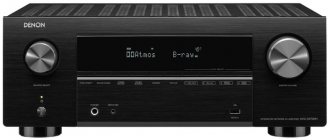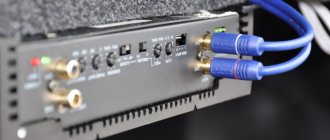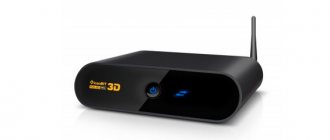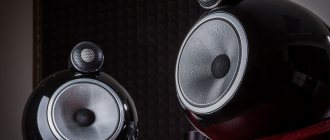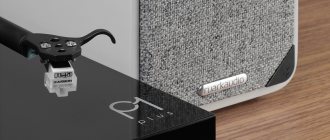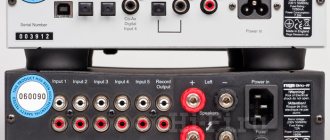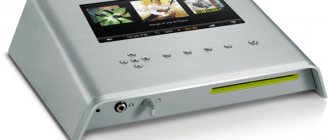Basics: What does a Hi-Fi system consist of?
According to the Sound Organization, a hi-fi system consists of three basic components: source , amplifier and speakers .
The source could be anything from a smartphone music streaming service to a record player or CD player.
An amplifier converts a weak electrical signal from a source into one strong enough to drive the speakers. Many sources have a built-in amplifier, even smartphones.
Finally, the speakers. In this regard, there is a wide choice, including wireless speakers, powerful floor-standing speakers, etc.
Review of the Rega System One Hi-Fi set (hifinews.ru portal)
Rega System One is a complete Hi-Fi system that uses a turntable to listen to music. This can be described as an unusual take on an all-in-one system, as it ends up in one box rather than being mounted in one case.
Hi-Fi devices designed to perform multiple functions have been produced for quite some time. You can remember the Chord Mojo DAC, one of the first attempts in this area. The Naim Audio Mu-so was much more capable and could actually work on its own or alongside models on the same streaming platform. Rega has a different approach to this. Since the company is known for its hi-fi components, its all-in-one system should consist of them. The choice of a vinyl player as a signal source is also not accidental - Rega players are very popular. It took almost two years to develop and finalize System One, which indicates the company's serious approach. It remains to find out what the efforts expended led to.
Specification and Design
System One consists of three different devices, each of which is also available separately. The system is supplied in one box and equipped with speaker cables (the player has a permanent connecting wire).
Planar One is Rega's most affordable turntable. Overall it's built on the same basic principles as the mighty Planar 10, but there are some significant differences. The most important thing is to reduce the overall weight of the player's structure. Another thing the Planar 1 has in common with the Planar 10 is that its platter is not made of glass, like most of the company's other models. While the Planar 10 has a ceramic platter, the Planar 1 has a thermoset plastic composite polymer platter. It's not as pretty as glass, but it works well as a record support due to its rigidity and significant weight.
The RB110 tonearm and Carbon cartridge are designed to work together, giving System One an added advantage. The tonearm does not require anti-skating adjustment, as it is already fully tuned for this cartridge. There's even a pre-installed rubber ring that, when pressed against the counterweight, will produce the correct 2 grams of downforce. This means you can take the Planar 1 out of the box and set it up to listen to records without using any meters at all, very quickly.
The reason the Planar 1 was chosen for this system rather than the Planar 1 Plus is that the System One's Rega Io integrated amplifier has a built-in phono stage. operates in class A/B, and its body is made of metal. It develops an output power of 2 x 30 W at a load resistance of 8 ohms, is equipped with two line inputs (in addition to Phono) and takes up no more space on the table than an A4 sheet of paper.
However, it cannot be called a minimalistic amplifier. The device is equipped with a remote control and has a headphone output. Yes, this amplifier is small, but it doesn't look like a toy. The device has only the necessary set of functions, but it is for this reason that it is perfect for daily use.
System One also includes Kyte speakers, which are new to the Rega catalogue. They are interesting simply because they required the company's engineers to be able to make high-quality speakers (meeting the Rega philosophy), but at a very modest cost. In fact, if you decide to build a hi-fi speaker in the UK using an MDF cabinet with Rega quality construction and finish, add speakers and a crossover, you won't be able to achieve anything within the system's budget. Therefore, Rega abandoned traditional technologies and made Kyte speaker cabinets from thermoset plastic composite polymer. Why not? This material allows you to obtain a durable structure, the speakers can easily be given an attractive appearance, and such a housing will cost significantly less than one made from MDF. Of course, such material also requires the development of new technologies, but Rega went for it.
The result is a rather unusual acoustic system, at least in this price category. The Kyte cabinets are a monolith of polymer, with the exception of the wooden front panel to which the speakers are attached. The body tapers towards the rear, which, given its cast structure, is quite easy to achieve. There is a cross-shaped tie inside to dampen vibrations. At the back there is a bass reflex output hole and a pair of terminals for connecting to an amplifier. Since all the walls of the speaker body are inclined, when placed on a flat surface, the front panel will be directed upward at an angle. That's why Rega packages the speakers with a pair of stands that attach to the rear panel and level the Kyte's position.
The acoustics feature a 125mm MX125 woofer with a treated paper cone and a ZRR soft dome tweeter. The tweeter is loaded onto a trimmed internal cone and has a special design to eliminate distortion due to re-reflections of sound waves. This is also a time-tested proprietary solution. The speaker impedance is 6 Ohms and the sensitivity is 89 dB. Frequency response is not specified, but this is a compact bookshelf speaker, so you can expect bass from 40Hz in the room.
The resulting system has two important features. Firstly, it looks and feels like a Rega system. With Planar 1 this is not so surprising, but in the case of Kyte, which do not look too similar to Rega acoustics, this also works. I think this is because, like most Rega models available, there is nothing superfluous about this speaker. It's this lack of embellishment that makes the Kyte look premium and at the same time completely recognizable.
Secondly, the whole system doesn't look cheap or put together haphazardly. It is well thought out, well made, easy to use and will look great in your living room. The Planar 1 has a protective cover, and while the Kyte doesn't have grilles, the tweeter's own protection should keep it safe in a world around kids and pets.
And finally - the obvious. By itself, this system only plays records, and for a lot of people reading this, it won't make much sense. However, it is important to emphasize that adding a digital source to System One is not a problem and can currently be done without great expense.
How System One was tested
The Rega system components were housed on a Quadraspire QAVX rack (electronics) and Soundstyle Z60 stands (speakers). The electronics were powered by an IsoTek Evo3 Corvus surge protector and I didn't use the included speaker cables because I have two pre-made LeylineX cables from Chord. In both cases I don't believe there will be significant differences in sound, I just found it easier to use pre-made connections. I then started adding and removing system components, which I'll cover later. The musical material used was mainly presented on vinyl, although FLAC and AIFF files were also used, as well as Tidal and Qobuz services (read on for how exactly).
Sound quality
I'm guessing many of you are thinking that I'm going to show how upgradable this system is and just say a little bit about what it is like itself. Yes, upgrading System One is possible and interesting, but first of all, this is a starter kit for a music lover. Combined together, these three ingredients deliver a concentrated dose of true British hi-fi. Bloc Party's The Prayer sounds great and invigorating through it. Planar 1 is a complete and very correct solution for the smooth flow of music. The sound is very exciting and at some point you realize that this is exactly how you want to listen to music.
The important thing here is that all three components are fully consistent with each other. is an inexpensive compact amplifier, but it has the same tonal balance and accurate rhythm reproduction as the Planar One turntable. It's funny in the sense that comparable priced single-component systems are not capable of such exciting sound. There's no DSP or fancy processing on the System One, and while I don't want to sound like a retrograde "it used to be better" style, it's great and the system sounds great.
Kyte fully conveys the character of the remaining components. I'd go further and say that this is one of the most unusual affordable speakers I've listened to in a while. It's all there: detailed and refined treble, decent tonal balance and, although not too large, a well-developed soundstage. The bass, of course, is not seismic, but on a pair of reliable stands it is quite sufficient for most musical genres. The Kyte are somewhat reminiscent of my own Acoustic Energy AE1. They also make you want to nod your head and stomp your feet to the beat of the music. That being said, the Kyte are much lighter to load and have a more comfortable overall sound character than the AE1. Listening to Ode to the Big Sea with its intricate and complex rhythmic patterns on the System One gives you an experience that was difficult to achieve on the much more expensive systems I've tested.
Rega System One not only allows you to evaluate the recording quality, but also enjoy the sound of your music. I find it difficult to name a system of any components of comparable total cost that would be capable of this. Equally important, much (not all, but most) of this same ability is retained when Io and Kytes are used with a digital source. I tested the System One with both the iFi ZEN DAC MkII and the Cambridge Audio DacMagic 200M, and the same great energy filled the music. And I suspect that adding, for example, a Rotel CD11 Tribute to this kit would produce excellent results.
And now about a possible upgrade of this system. When the time comes, you can, for example, install an Audio Technica VM95 series pickup on Planar 1, or perform another upgrade. You can swap it out for a Planar 3 or even a Planar 6 and the Io amp with the Kytes speakers will let you hear the upgrade in sound quality. Just for fun, I even used a Planar 10 with a Vertere Saber cartridge in this system. And again I heard changes in the sound. Has this player reached its potential? Of course not. But it was a very brave attempt.
In fact, my experience testing System One allows me to make the following bold statement. You can replace any of the three components of the kit with a component that costs several times more, and the overall sound quality will improve significantly. I used the Q Acoustics Concept 30 instead of the Kytes and the results were great. The Roksan Attessa amplifier with streaming function instead gave a slightly less impressive result, and we have already talked about the possible use of the Planar 3 player in the system. No single-component system can provide such flexibility in use.
Conclusion
It probably won't come as much of a surprise if I report that the System One is a very good deal. This is a true Hi-Fi kit that you can now buy in one box. The system is easy to install and connect, and is a true Rega, both in sound and appearance.
What audiophiles will get with the purchase of System One is an immediate result of my 20 years of searching and building hi-fi systems. Yes, today I can afford (and use) higher-end components. But I envy those who can start their hi-fi journey right away with System One. This is undoubtedly the “Best Buy” today.
Verdict
The Rega System One is one of the most enjoyable things I've tested in a very long time. This small but well designed model has everything a true hi-fi system should have. This is a great, easy purchase and I have no doubt that the Rega System One will become a best seller in the market.
Liked
Incredible sound quality for the price
High quality workmanship
Good set of functions, upgradeable
Did not like
No digital source
Ratings: Build quality: 9 Connectivity: 9 Ease of use: 9 Sound quality: 9 Features: 8 Quality/price: 10 Verdict: 9
Original article here.
When preparing the review, materials from www.avforums.com were used (translation from English - hifiNews.RU) Original: https://www.avforums.com/reviews/rega-system-one-review.19438
01/25/2022, Nikolay Sergeev
Portal www.hifinews.ru
Setting a Budget
Building a Hi-Fi system doesn't always have to be very expensive.
Of course, if you want, you can spend at least millions.
But if you want to save money, you first need to look at what components you already have at home. You can use a smartphone, laptop, or TV as a source. They are capable of connecting to wireless speakers from companies like Sonos, Bowers & Wilkins , Harman Kardon.
If you find a vinyl record player, check it for a built-in phono stage and amplifier. If they are, you can save on buying external ones. You can also save money by purchasing an all-in-one device like the Onkyo TX-8270 . All that remains is to add columns to it.
Onkyo TX-8270
Whatever combination of source, amplifier and speakers you choose, you need to set yourself to a realistic budget. At any time, you can add new components to the system if you want to improve its quality.
Antiquities: A Second Approach to VHS, Hi-Fi Stereo and Soap Video
2020 The quality of video material over the past five years has been so high that it seems as if it’s no longer necessary to get better. The 8K format is approaching, 32 million pixels in each frame, you can already buy a suitable monitor or TV, but there is not enough content. In five years, I’ll buy a new smartphone, take an 8K video selfie, and in all its glory I’ll look at a bunch of new wrinkles, gray hair and wrinkled facial textures. As you grow older, you make progress, for some time you move along the rails of life in line with it, and then you fall behind: your health is no longer the same, your emotions have faded, the force of habit takes its toll. Increasingly, in response to any new product, technical or cultural, you grumble: they invented it there, why, they throw it away for garbage, but in our time
... So, in
our time
we didn’t watch movies on a computer. There was no YouTube, the value of moving pictures was higher - you still had to get a video cassette.
I keep a diary of a collector of old pieces of iron in Telegram.
In the beginning there was television
It all started when I bought a CRT TV in April 2022.
Well, when I bought it, I took it for free from the owner who wanted to free up space. It was that moment in my retro hobby when you first do something and then regret it: the 28-inch widescreen Sony was completely unaffordable. But if this happens, you will have to buy a VCR, and not only that. Yes, I already had an idea about the “quality” of VHS, and even visually compared it with DVD and 4K in a previous article on the topic. I wondered why videotapes are like this? Somewhere in the depths of specialized knowledge, this comes down to parameters similar to those of an audio cassette: signal-to-noise ratio, permissible frequency range, various interferences during the magnetic recording process. To substantiate all this correctly, and even more so to measure it not by eye, but by instruments, is still beyond my capabilities. But you can do an experiment.
The photo above was taken with a modern digital camera and cropped to an aspect ratio of 4 to 3. I adjusted the vertical resolution to the 4K standard - 2160 pixels. At the beginning of the 2000s, I bought the first computer video card with a TV output and even then I was surprised at how dull the image on the TV was compared to the monitor. Although it seems that both there and there at that time had a similar cathode ray tube.
Indeed, monitors of those years received images from a computer in analog form, but the connection type was component
: Separate wires carried the red, green and blue components of the video signal, plus synchronization.
This provided high resolution and decent image quality. Even now, LCD monitors with a VGA connection provide a picture that is slightly worse than DVI and HDMI. Household TVs worked with a composite
signal: it is transmitted over one pair of wires, and contains two components superimposed on each other: brightness and color.
The video signal format complies with the analogue television broadcasting standard, and today let’s not even remember that there were many of these standards. You shouldn't get involved in this topic
.
Let's focus on the PAL standard: it provided the transmission of 625 image lines, of which 576 were visible. Let's take our reference photo, reduce it to a resolution of 768x576 and burn it to DVD with the maximum bitrate. The photo above is capturing a composite video signal from a DVD player. This is our VHS source. I wanted to show that before enjoying the quality of a VCR, you need to understand that at the entrance to it it was not at all ideal for modern times. Of the theoretical 576 TV lines, the actual resolution of the composite signal is 400, after recording on VHS it drops to 200-250.
We record the picture on VHS, play it back and digitize it back using a DVD recorder (on the left is the composite output from DVD, on the right is VHS). The signal parameters on the magnetic tape are the same as for the incoming video signal: 625 lines, 50 half-frames per second. The bandwidth, the equivalent of “resolution” for an analog signal, is reduced. In the composite source, the bandwidth is 5 megahertz, on VHS - 3 megahertz. The number of lines does not change, but, as can be seen in the picture above, image clarity suffers, and most of all, color reproduction. Let's add to this the traditional consequences of recording on magnetic tape: more noise, penetration of interference from an adjacent frame. We get a warm lamp image.
Final comparison (
). On the right is the present tense. On the left is how we watched the video 30 years ago. VHS has never been the best medium for composite video. Even if we forget about professional equipment, there were also consumer formats with much more worthy characteristics. But VHS was cheap and easy to use, which is often more important than “quality.” However, when choosing a VCR for my collection, I wanted to get closer to the times when VHS was more expensive than a car.
When VCRs Were Big
If you are going to buy a VCR in 2022, then you need to buy the best one. VHS home video technology evolved until the advent of DVD in 1996, but I really don't like the look of that "late" technology. I will give a photo of the device from the previous article. It’s generally from the early 2000s, but the trend is clear:
Boring, simple, no screen. Okay, let's take something from the second half of the nineties:
Photo from here. A little better, but still not the same. I want a holiday, but here there is none, just gray everyday life. You can’t even say that VHS devices have survived simplification - you can find a device filled with features from the sunset era. Maybe I'm just not a fan of nineties design. We need to go further into the past, but another risk arises: the older the device, the greater the chance that it is broken. The fewer devices are in decent condition. All the more incomplete, rotten rubbish from years of storage in the barn. The likelihood of getting a broken brick increases significantly.
And I ended up buying a Sony SLV-815 tape recorder. The top model of 1991, a device with a bomb design, with wooden panels on the sides and stuffed to the maximum with features. A serious VCR for video editing, built to look good in a hi-fi rack.
The VCR was sold with the mark “estate”, which usually means that the first owner is no longer with us, and a hired manager is responsible for the sale of things, who will not check anything. From here there are two conclusions: the external condition will most likely be good, but as for performance, you will have to play the ebay lottery.
And so it happened. The Sony service center sticker was reassuring, hinting at service or repair in April 2002. Externally, the device looks new, the screen is working, only the segments that are constantly on (the clock) have noticeably dimmed. To my deep satisfaction, the VCR started working almost immediately, although not on the first try, but on the second.
Only during playback you can clearly hear the crunch of the gears - it would be better to lubricate it. Tape recorders of this era suffer from broken plastic elements of the mechanism, dried out capacitors, sawn heads (if used constantly). And they are simply complex, requiring certain experience and qualifications during restoration. What's good about this tape recorder? What were the important criteria for choosing VHS in those days? Some things are not relevant at all now, for example, flexible programming of recordings a year in advance. The basic division of video equipment was as follows: a full-fledged video recorder (equipped with its own TV receiver, can record TV programs in real time and on a schedule), a video player (only plays cassettes) and a recording video player (can record, but is not equipped with a tuner - the TV must work with it, no recording programming).
What else is there? Editing capabilities. The panel has an encoder with a rotating central part and a rotating ring - almost like in professional equipment. With its help, you can control video recording at different speeds, in slow rewind mode or frame by frame. Precisely position the tape in the right place and turn on the recording, with a seamless transition between fragments. You can add another audio track to the video. Or even connect a microphone and add a director’s commentary to the recording of a trip to the bathhouse.
The tape recorder is equipped with a LANC interface for interaction with other devices. For example, it can give a command to turn on the satellite receiver and switch it to the desired channel. Or you can buy a special editing console, as in the picture above, and control two VCRs (or a tape recorder and a camera) at the same time. Yes, this machine can be controlled using Arduino.
In general, it turns out to be a fairly functional, albeit consumer-grade thing for a wealthy enthusiast. For editing video from a camcorder, creative recording and editing from TV or other sources. I’ll add a couple more interesting finds to the feature descriptions. This is the Video Programming System - an older implementation of the PDC standard. At least on European television, code signals for the start of the broadcast were transmitted. The VCR was able to receive them and adjust the schedule so as not to record a part of the previous program or the next one.
Another term from the late eighties is Simulcast. This is when the broadcast of a television program on TV is accompanied by synchronized transmission of stereo sound over the radio at FM frequencies. For this case, the SLV-815 provides a special mode: we record video from the air, and sound from an external radio receiver.
On-screen display was still a novelty in 1991. The advertising slogan “Digital Picture” in the SLV-815 refers to it, there is no digital image processing here. But there is a “picture in picture” mode (we watch a video cassette, watch the TV when the desired program starts there). The on-screen menu has been removed from setting up TV channels and a couple of useful functions: “rewind the tape to the beginning and throw it away” (for rental), “rewind to the zero mark of the counter” and so on. In addition, as expected from a functional VCR, this Sony can predict the remaining tape. This is all very cool, but the soapy VHS retro experience wouldn't be complete without one more inevitable accessory.
Tsar-remote
It's huge! Designed for enthusiasts, the remote control provides control over all functions of the VCR. And if this doesn’t seem enough to you, just lift the lid. There seems to be a button for everything.
A significant part of the remote control is dedicated to recording programming. An LCD display is provided for this purpose: you can set the start and end intervals for recording directly on the remote control, and then transfer it to the VCR with one click. It’s impossible to understand all these features without instructions, although I didn’t need much to set the correct time on the VCR.
Of course, I figured out how to do it, but it didn’t help much.
The date on the remote control is set in the most crooked way: “rewinding” by day starting from January 1991. Moreover, the calendar is limited from above to 2006 - apparently the developers thought that in 15 years no one would use this device anymore. You guessed wrong! The remote control is designed to work in a complex, expensive home system. With it, you can control three VCRs at the same time, and turn the TV on and off. In fact, it is beautiful, but inconvenient: most often I use the TV remote control. It is smaller and allows you to control the basic features of the tape recorder.
Hi-Fi Stereo and reel-to-reel shaming
In the previous review of video equipment, I only mentioned the Hi-Fi Stereo mode, but now I decided to study it more carefully.
The VHS standard provided for recording sound on a separate monophonic track using a stationary head. Accordingly, the sound quality depended on the speed of the tape, and in VHS it is small - 2.339 centimeters per second, half that of an audio cassette. In 1984, they came up with another way: recording sound using two additional heads on a rotating drum, just like video. This was not an easy task, since the video tracks are arranged as tightly as possible. They did this: the sound is recorded on tape before the video. The video signal partially erases the audio tracks, but due to differences in the azimuth of the heads and signal strength, the audio can be read and decoded. And that’s exactly what it is encoded: using frequency modulation, the analog signal is “driven” into the frequency range of about one megahertz, to reduce interference from the color and brightness components of the video. The frequency distribution using VHS Hi-Fi is shown in the graph above.
Despite all these manipulations, the audio signal in Hi-Fi Stereo mode remains analog. But its parameters are seriously increasing. And if so, I would like to somehow objectively measure them. It didn’t work out right away: the VCR is not friendly with the desktop, receiving a lot of interference from it (and it seems that it doesn’t like the presence of switching power supplies nearby). I had to measure it using a laptop running on batteries.
From left to right: VHS Hi-Fi, standard audio track, also in LP mode, and for comparison - a type 1 audio cassette and a modern digital audio player, which served as the source for all tests. A hi-fi track shows results that are at least as good as a very good reel-to-reel tape recorder at 19 or 38 speed. The theoretical dynamic range of the standard is 80dB or better. In practice, I got 77dB, and considering the age of the device, this is worthy. On traditional magnetic tape, this result is only possible with a noise reduction system. But the main thing is a smooth amplitude-frequency response and a low level of distortion. By the way, is the frequency response of a VCR limited? What if we apply a test signal to it in the range of up to 48 kilohertz?
It is not limited at all - within the usual plus or minus 3 dB, the upper limit of the frequency response ends almost exactly at 30 kilohertz. You can record high-definition sound if someone suddenly thinks of it. So VHS Hi-Fi is the best (and last) medium of warm tube sound on magnetic tape? Well almost. The problem is that audio is recorded in 1/50 second chunks. The slightest synchronization failure and a terribly annoying crackling sound appears. In the video above I gave an example of such characteristic distortions. It is easy to cause them artificially; it is enough to “knock down” the signal synchronization by manual adjustment. But sometimes they appear on their own: tape defects, worn-out mechanisms, storms on Mars. A cassette would be better, but without these artifacts. In the eighties and nineties, VHS Hi-Fi was an attractive topic for music lovers and audiophiles. The sound characteristics do not change in any way even when switching to a lower LP recording speed. You can record six hours of music on a three-hour cassette. Even if you manage to avoid interference, it is not very convenient. The format turns out to be strictly stationary. Navigation is difficult, although the VCR can place markers and move between them. In general, not really my choice.
But VHS Hi-Fi seriously improves the experience of watching movies on video cassettes. Yes, the picture is a little fuzzy, but the sound is fine, no worse than a digital soundtrack. In the video above I recorded a comparison of VHS Hi-Fi with a standard track in SP and LP modes. In the first case - decent sound without complaints. Standard audio is monophonic (some models of tape recorders were able to record in stereo) and tolerable. The sound in LP mode is more like the sound of a radio. Recording vintage video clips with stereo sound is a pleasure. You can also record a cassette with a double or even triple audio track. For example, we record the original sound of a film without transferring it to Hi-Fi. Then separately - transfer to a standard audio track. The Sony SLV-815 settings provide the ability to randomly switch between audio tracks, output one of the stereo channels, or mix everything at once.
Branded video or what was missing in childhood
In the VHS reality of the early nineties, I was at the very bottom of the VCR experience. My videotapes were either self-recorded (with interference), or rental (of terrible quality and unknown origin), or purchased (a little better, but still pirated). I tried to fix it, especially since now it doesn’t pose a problem at all. VHS is still regarded by most people as old, useless junk.
There have been a lot of video releases, they can be found for free, with pickup, or cheap, or a little more expensive, but sealed. I purchased several cassettes from Europe, with the original soundtrack. These are late editions, usually large-format, in a standard plastic case, or even collector's editions - in a box and with beautiful printing.
Watching the theatrical version of a film on video is a controversial idea. Let's remember about the resolution of 200-250 real TV lines. Wide format black bars will eat up a third of the format's small capabilities, and the output will be a picture that can roughly be compared to digital video in a resolution of 335x100. So a typical VHS release will crop the image around the edges to get rid of the black bars. About half of the theatrical frame is lost. Sometimes, however, the opposite happens.
The famous shot from “Independence Day”, known as TUCHA FZNAMZON, is presented in all its glory in the television version. In wide format, half of the inscription in bad Russian is cut off.
Since I mistakenly bought two editions of the first three Indiana Jones films, I can compare the widescreen edition and the regular edition. That’s how they were sold: a choice of watching the director’s vision in its entirety, but with black stripes, or without stripes, depending on your luck. Here you may notice that the image does not take up the entire area of the frame. The fact is that a correct, vintage CRT TV does not show it (a phenomenon known as overscan).
We have long been accustomed to the fact that modern TVs and monitors show the entire image, with ideal geometry. And then the picture on TV was projected with a reserve, and the noise from switching heads in the lower part of the frame had to be removed. Returning to the “lines” or “TV lines”: not only is VHS low in resolution. So you simply won’t see part of the useful signal. I'd like to show my new thirty-year-old VCR in action, but uploading films to YouTube is not a good idea, even for research purposes. One of the tapes in my collection is from a video rental store. They are distinguished by the presence of a trailer for “new” films at the beginning. Here's one of the trailers I'll show you. Here the video is captured by another recorder, which takes into account the overscan phenomenon and additionally crops the edges of the image. As per tradition, I converted the original PAL image to 4K format.
And let's look at the still from the movie again. Almost all films are now available in FullHD or even 4K resolution. Another way to evaluate progress over the past three to four decades. Is the VHS format adequate in 2020? It is only interesting if you, like me, are interested in retro technology. I am incredibly impressed with both the design and capabilities of my VCR. But the limitations of magnetic video recording, which is not of the highest quality, are obvious. Even if you watch the above video examples on your phone. I will say this: VHS does not need to be viewed on LCD displays in principle. Only CRT, only hardcore and period-correct equipment. An old TV adds its own distortion to the VCR, but makes the picture juicy, creating exactly the mood with which we watched videos in the eighties and nineties. It’s for these vintage sensations that I actually get all this junk. Authentic films from that era, preferably with a distinctive one-voice transfer, look great on VHS even in 2022. Videos from the Eighties are often recorded in "composite" quality from the start, and look soapy even when re-released on digital media in 4K, like the video clip above. This is the right content for which I purchased the right set of devices. Unlike audio cassettes, which sound fine
, and vinyl, which is experiencing a renaissance, the age of analog video is now very noticeable. Returning to VHS is akin to buying a Spectrum or an early IBM PC, a trip back in time, a swim down the waves of memory. Studying ancient artifacts, and at the same time trying to understand oneself. Or simply an illogical way to achieve mental comfort by building a time capsule in your office.
That's how we live.
Cables and other components
Nordost 2 Blue Heaven
If you have a wired system, you need to remember to buy cables. High quality cables can be expensive. But for starters, regular copper cables from one of the well-known manufacturers, such as QED .
If you choose bookshelf speakers, you should also decide whether you need stands for them, or whether you want to hang them on the wall.
B&W STAV24 S2 SPEAKER STAND BLACK

